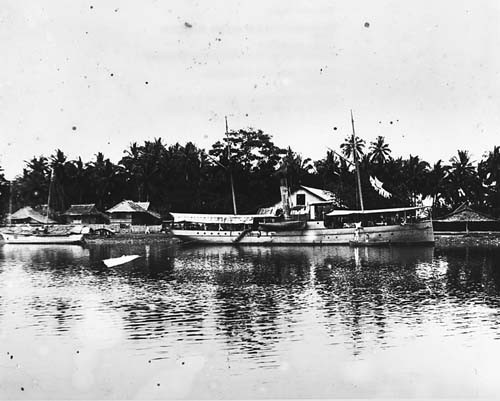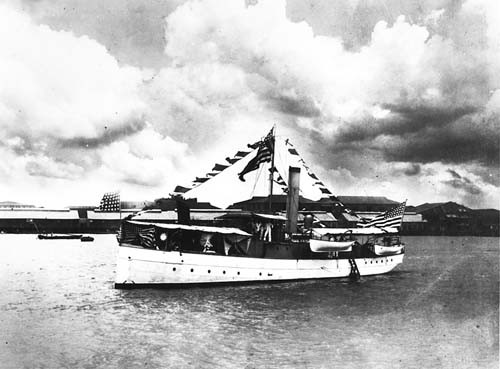Samar I (Gunboat No. 41)


Previous name retained.
I
The first Samar, launched in November 1887 by the Manila Ship Co., Canacao, Philippine Islands, for the Spanish Navy, was captured during the Spanish-American War, acquired by the United States Navy from United States Army authorities on 9 November 1898 at Zamboanga, convoyed to Manila 13-20 April 1899 and commissioned at Manila on 26 May 1899, Ens. George C. Day in command.
Following local operations out of Manila that summer, Samar patrolled off Negros and Panay, assisting Army operations ashore. In November the gunboat helped escort an Army Expeditionary Brigade under Brigadier General Lloyd Wheaton to San Fabian in Lingayan Gulf, then firing on insurgent entrenchments on the landing beaches. The gunboat served out of Vigan in northwestern Luzon into the new year, cruising on patrols, carrying detachments of troops and maintaining communications in the region. On 24 April 1900 the gunboat carried Brigadier General Young on a tour of inspection from San Fernando to Vigan. In May, Samar carried pay and supplies to Bojeador lighthouse and, in June, carried a detachment of the 33d Infantry from Aparri to Kandon. Returning to Aparri, the crew spent a few days scaling the boiler and overhauling the engines before conducting a survey of the Kagayen River with Bennington 20-21 June. Following a short overhaul at the Cavite Naval Station, the gunboat sailed south to Zamboanga in southwestern Mindanao, where she patrolled from Cebu in the north to the Jolo island group in the south into 1901. Admiral John A. Schofield, then an Ensign commanding Samar, later wrote the gunboat captured a banca in a cove off Paragua and rescued two "fair young maidens" who had been kidnapped by bandits from the town of Puerto Princessa. At the start of the rainy season that summer, the gunboat proceeded to Cavite, Luzon, for boiler repairs and was decommissioned on 23 September 1901.
Recommissioned on 19 June 1902, Lt. Montgomery M. Taylor in command, Samar steamed south to Zamboanga, Mindanao, where she carried messages and stores for Marine detachments assisting the Army in suppressing the Moro rebellions among the southern islands. She patrolled the Sulu Archipelago as well, visiting ports throughout the island group and stopped for coal at Sandakan in British Borneo as required. The gunboat returned to Cavite in December, in preparation for fleet maneuvers with the Southern Squadron of the Asiatic Fleet in January 1903. After fitting out for survey work at Canacao in February, Samar began hydrographic surveys off southern Mindanao. area, conducting an extensive survey of Polloc harbor before supporting Army operations at Simpetan. Following the closing of the Naval Station at Polloc in June 1904, the gunboat returned to Cavite and decommissioned there on 22 August 1904.
In late 1909 the gunboat changed station to Shanghai, where she regularly patrolled the lower Yangtze River up to Nanking and Wuhu. Following a anti-foreign riots in Changsha in April 1910, which destroyed a number of missions and merchant warehouses, Samar sailed up the Yangtze River to Hankow and then Changsa to show the flag and help restore order. The gunboat was also administratively assigned to the Asiatic Fleet that year, which had been reestablished by the Navy to better protect, in the words of the Bureau of Navigation, "American interests in the Orient." After returning to Shanghai in August, she sailed up river again the following summer, passing Wuhu in June but then running aground off Kichau on 1 July 1911. After staying stuck in the mud for two weeks, Samar broke free and sailed back down river to coal ship. Returning upriver, the gunboat reached Hankow in August and Ichang in September where she wintered over owing to both the dry season and the outbreak of rebellion at Wuchang in October 1911. Following the collapse of the Qing Dynasty and the declaration of the Republic of China by Sun Yat-sen that winter, tensions eased and the gunboat turned downriver in July 1912, arriving at Shanghai in October. Samar patrolled the lower Yangtze after fighting broke out in the summer 1913, a precursor to a decade of conflict between provincial warlords in China. Following another cruise upriver to Hankow in February 1914, the gunboat returned to Shanghai for an overhaul in March.
Samar remained on the China Station throughout World War I, then, in July 1919, was placed on the disposal list at Shanghai following a collision with a Yangtze river steamer that damaged her bow. A year later, she was designated PG-41, but was ordered inspected and appraised for sale the same day, 17 July 1920. The following month she returned to Cavite, where she was decommissioned on 6 September 1920 and sold on 11 January 1921.
Rewritten 05 October 2007, Dr. Timothy L. Francis


